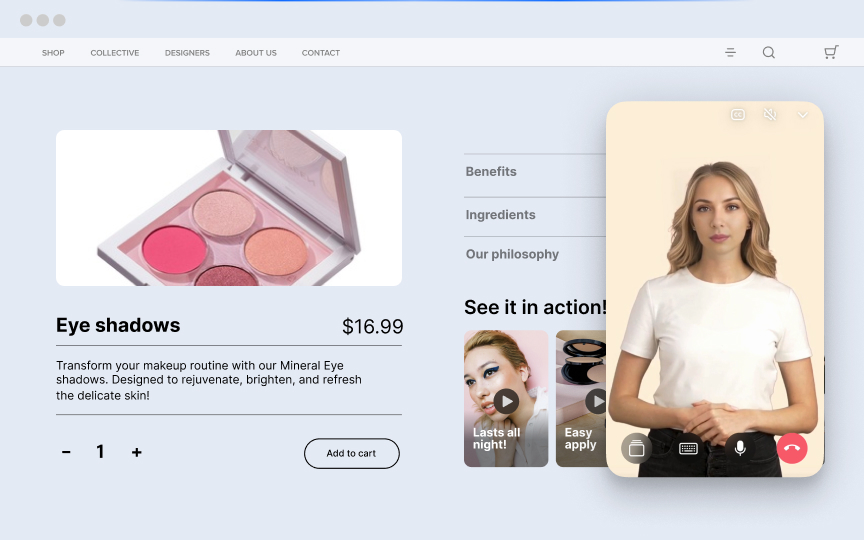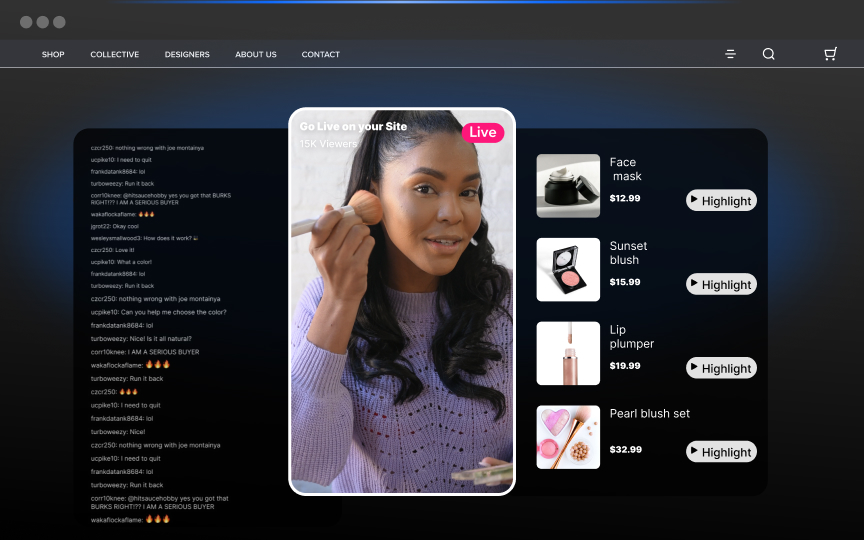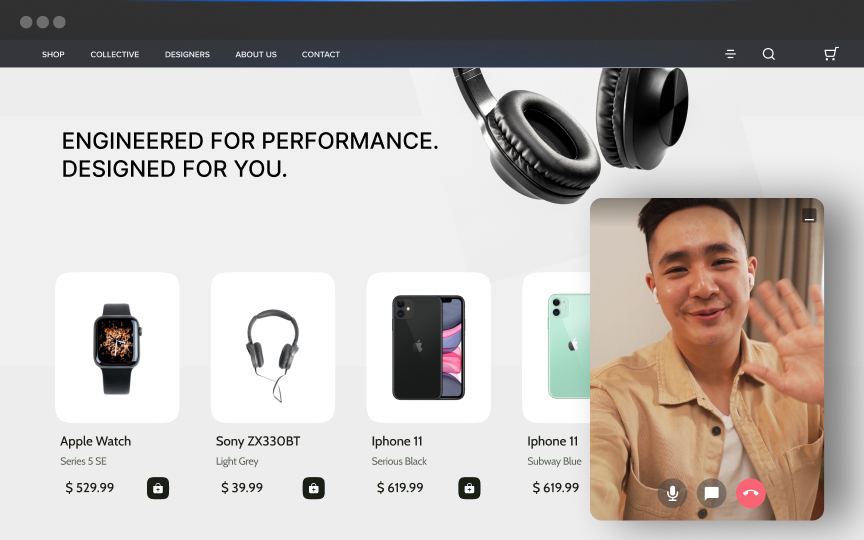Consumer buying behavior remains the leading metric for growth and success for retailers and eCommerce businesses. It remains the make-or-break factor in selling. While online shopping had grown during the pandemic, the physical experience of being in-store and assessing product quality in person continues to rule customer buying behavior.
Reports from Euromonitor suggest a 78% retail market by 2024 with parallel eCommerce growth. Globally, customers have recognised the leverage of online shopping or eCommerce. Statistically, 72% of the global audience has shifted completely to the digital marketplace.
Brands are leveraging a combination of online and offline buying strategies in the form of phygital experiences to fill this need. It might sound like an absurd typing error, but ‘phygital’ is the literal outcome of physical-meets-digital. Here’s everything you need to know about phygital experiences and how they boost customer engagement for brands worldwide.
What is Phygital?
Phygital is more than just a buzzword in the marketing world. The omnichannel strategy combines the best digital and physical realms to create a superior customer experience. Phygital, as the name suggests, combines the advantages of physical surroundings, such as interacting with goods, with the benefits of digital environments, such as speed and comfort. In addition, it powers the discoverability of products and services from the comfort of the consumers’ homes.
What Are Phygital Experiences?
According to statistics, 77% of consumers prefer internet shopping. In contrast, 23% of customers prefer to visit physical stores because they can assess the quality of the products personally and have greater confidence in the item they buy.
In this scenario, the midway works best for the brands. Certainly, phygital experiences are the secret to building trust and customer loyalty by showcasing the best of both worlds to your audience. Let’s look at two situations:
1. ROPO (Research Online, Purchase Offline)
Customers research the products they desire online, but checking factors like quality, look and feel in a physical store is a classic example of ROPO. Online research can vary between checking out the prices at the eCommerce store or livestreaming products on the website.
2. Showrooming
It is the procedure of doing offline research on a product in a physical store before making an online purchase. This enables customers to benefit from home delivery and online deals. in each situation, the customer relies equally on both mediums before taking a final decision. Similarly, businesses are dividing their attention between online and offline structures to create unique customer experiences.
Why Is A Phygital Experience Necessary For Your Business?
Phygital experience packages a good deal for businesses. It has widened the range of selling, enabling growth at multiple levels. Two prime reasons why your business must build the phygital experience are:
1. Increased Sales Opportunities
Your customer has the chance to experience products, both online and in-store. This assures them of the choices they make and gives them the confidence to go ahead and buy the product.
2. Better Customer Experience
Phygital customer experiences include the best of both worlds. Users would return to your brand knowing they can livestream your products and purchase them in-store.
How does Livestream Shopping Help You Deliver A Phygital Customer Experience?
Livestream shopping is an emerging form of phygital engagement that encourages customers to visit stores and shop. A typical shopping cycle begins with a customer noticing a product and then researching its brand and reputation. Approximately 63% of people discover products online and complete the purchase process in person.Livestream shopping has the added advantage of interaction apart from appealing to the customer’s audio-visual senses, making them feel involved and comfortable simultaneously. From giving the customer a sneak peek of the product to acquainting them with brand representatives and influencers, the ‘phygital experience’ quotient is high in livestream shopping. It offers a comprehensive experience where businesses can livestream a range of products to their audience. The audience gains a better understanding of the product from these videos, saving them time from in-store research.
How Do Phygital Experiences Help Your Brand?
Phygital customer experience unpacks huge benefits for businesses and brands, especially in eCommerce. These are a few of the many benefits phygital experiences offer to brands:
1. Better Brand Loyalty
Your customers stick around for a long time when they enjoy a holistic shopping experience with little room for doubt and confusion.
2. Build Brand Awareness
Be known as the brand that gives both physical and digital experiences. It helps you earn the trust of your customers much faster than a linear approach.
3. Prevent Stockouts
Phygital experiences lead to unified inventory management, allowing you to keep a close check on quantities and prevent stockouts.
4. Superior Customer Experience
Phygital is synonymous with convenience. The flexibility allows customers to experience the brand in every way possible.
5. Increased Sales with Personalisation
The immersive phygital experience personalizes the customer journey with interactions, which boosts the brand's sales.
How Can Your Retail Brand Implement A Phygital Experience?
Brands may provide a phygital experience by utilizing various resources such as livestream media and product videos.Livestreaming enables businesses to show product launches and marketing initiatives to a larger audience. It is one of the rapidly expanding tools millions of global brands use. Suppose you own a cafe with a beautiful ambiance, for example. In that case, you can utilize livestreaming videos to showcase the location online and let visitors reserve a seat using a link integrated into the video.A widely accepted formula for invigorating phygital engagement is 3 Is -
- Immersion - Making the consumer a part of the whole experience, from browsing to purchasing.
- Immediacy - The buyer misses on nothing with the right deals at the suitable times. They get to purchase via any medium they prefer.
- Interaction - This is the ultimate component of phygital experiences, where interaction with brand personnel and influencers gives the consumer an idea about the look and feel of the products.
Brands all over the world have leveraged technology in creating innovative phygital experiences. Gucci started offering its AR-powered app for virtually trying on its Ace Sneakers Collection. In 2021 another top brand, Tommy Hilfiger, came up with smart fitting rooms using Radio-Frequency Identification (RFID) and touch screen technology. The innovation in India also continues.
Phygital Retail Examples And Use Cases
1. Fluff Leveraged Shoppable Videos:
FLUFF is a DTC home products brand that brings the 5-star hotel experience straight to people's homes. To interact with customers on their website and develop relationships with next-generation buyers, FLUFF employs Firework's shoppable videos.

Shoppable videos with descriptions pop up on the Fluff website, making the phygital experience more engaging.
(Source: Fluff)
The shoppable videos on their website reduced customers' need to follow them on multiple media platforms. Basically, one can shop directly from these videos, with product descriptions and the option to check out. A case study reveals that they witnessed an 89% increase in conversion rate and a 98% increase in average order value!
2. Adidas Showcased Shoes in 3D Rendering:
Global leader Adidas makes remarkable efforts to develop holistic phygital experiences for its customers.

Adidas’ store creates immersive experiences with 32 digital touchpoints, including ceiling screens and digital plinths.
(Source: Economic Times)
They have digital features sprawling throughout their physical stores. These include fitting rooms with RFID mirror technology, a hanging chandelier, individualized concierge service, and even a hype wall showcasing shoes in 3D rendering. The idea behind creating this space was for them to create a space where people could gather, discover and participate.
3. Allbirds Digital-only Sustainable Strategy:
This sneaker startup took the industry by storm with its digital-only product offerings. In 2020, they released an iOS app where customers could learn about their newest items, virtually try them on, receive alerts about special offers, and even assist the company in its environmental efforts to minimize carbon offset.

Allbirds has 35 retail outlets as of 2021. A digital-only platform to increase phygital customer engagements.
(Source: Footwear News)
However, the eco-friendly brand has 35 physical stores (as of 2021) dedicated to creating the complete phygital experience. Their physical retail sales doubled in 2021, growing 112% to $52 million.
4. Chanel Next-gen Phygital Campaign Using AR:
Luxury fashion leader Chanel has installed AR smart mirrors in the changing rooms of its flagship stores.

Chanel’s AR-powered fitting rooms provide one of the most immersive phygital experiences in the business.
(Source: Fashion Network)
Customers select from various products via an app, then book an appointment to try them on. The chosen items are brought to the consumer when they arrive, and they can use a cutting-edge mirror to zoom in on the product details. This results in a seamless shopping experience that combines high-tech elements with boutique and one-on-one shopping.
5. Timberland's NFC campaign:
Timberland adopted TouchWalls in their Manhattan shop in 2016 to enhance the in-store experience. Customers are given access to an online-only inventory via digital screens, where they can touch product images for more information and create custom shopping lists.
CloudTags Timberland Connected Store from cloudtags on Vimeo.
Timberland TouchWalls is one of the best phygital retail examples
(Source: Vimeo)
To improve retail and remarketing experiences, Timberland collected data from the interaction between the NFC (Near Field Communication) tablets provided by the store, the touch wall, and the customer visit.
6. Nike's Pop-up Store:
Nike has been experimenting with a new kind of neighborhood-focused pop-up store since the summer of 2018. Moreover, the Los Angeles Nike by Melrose location was planned using data from the city's NikePlus members. These observations subsequently influenced the development of store-specific product lines.

Nike by Melrose’s app to store phygital retail experience.
(Source: Google)
Members may access curbside returns by texting the shop, booking product testing sessions, reserving items for pickup, and redeeming incentives in-store via the Nike app.Nike Live has been such a hit that in the fall of 2019, the sports retailer opened two more locations in Long Beach and Tokyo.
7. Alibaba's Revolutionary Livestream via Taobao Live:
The retail giant has embarked on a ‘New Retail’ journey, where it has been creating phygital experiences across its initiatives.

Tabao, the livestream shopping platform by Alibaba
(Source: Marketing to China)
Alibaba’s livestream shopping initiative Tabao is one such game changer. Established in 2016, Tabao accounted for 89% of eCommerce sales by livestreaming on its website. It gained further momentum in response to the pandemic, especially after removing service fees in February 2020.Taobao runs on AI experiences, various content formats and interaction with influencers who help create brand loyalty and trust.
Wrap Up
Phygital experiences have ushered in a new age of marketing. Customer engagement is instant; there is vast potential for contact, bringing them the ease and convenience they desire. The retail world has experienced more innovation as they adapt to changing customer buying patterns. Brands can build up from the best of both realms (digital and physical) and provide their audience with an experience that keeps them around for a long time.
Unlock Exclusive Insights
By submitting this form, you agree to Firework's privacy policy and consent to receive personalized marketing communications. You can unsubscribe at any time.


























.png)






